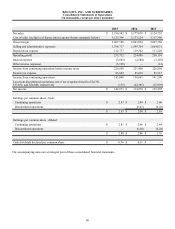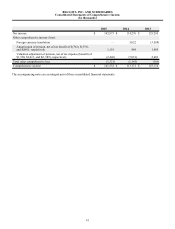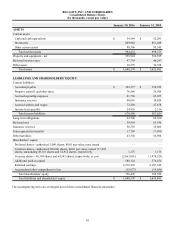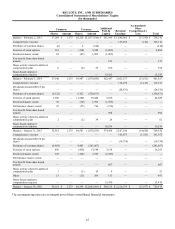Big Lots 2015 Annual Report Download - page 126
Download and view the complete annual report
Please find page 126 of the 2015 Big Lots annual report below. You can navigate through the pages in the report by either clicking on the pages listed below, or by using the keyword search tool below to find specific information within the annual report.49
Revenue Recognition
We recognize sales at the time the customer takes possession of the merchandise. Sales are recorded net of discounts and
estimated returns and exclude any sales tax. The reserve for merchandise returns is estimated based on our prior return
experience.
We sell gift cards in our stores and issue merchandise credits, typically as a result of customer returns, on stored value cards.
We do not charge administrative fees on unused gift card or merchandise credit balances and our gift cards and merchandise
credits do not expire. We recognize sales revenue related to gift cards and merchandise credits when (1) the gift card or
merchandise credit is redeemed in a sales transaction by the customer or (2) breakage occurs. We recognize gift card and
merchandise credit breakage when we estimate that the likelihood of the card or credit being redeemed by the customer is
remote and we determine that we do not have a legal obligation to remit the value of unredeemed cards or credits to the
relevant regulatory authority. We estimate breakage based upon historical redemption patterns. For 2015, 2014, and 2013, we
recognized in net sales on our consolidated statements of operations breakage of $0.4 million, $0.2 million, and $0.2 million,
respectively, related to unredeemed gift card and merchandise credit balances that had aged at least four years beyond the end
of their original issuance month. The liability for the unredeemed cash value of gift cards and merchandise credits is recorded
in accrued operating expenses.
We offer price hold contracts on merchandise. Revenue for price hold contracts is recognized when the customer makes the
final payment and takes possession of the merchandise. Amounts paid by customers under price hold contracts are recorded in
accrued operating expenses until a sale is consummated.
Cost of Sales
Cost of sales includes the cost of merchandise, net of cash discounts and rebates, markdowns, and inventory shrinkage. Cost of
merchandise includes related inbound freight to our distribution centers, duties, and commissions. We classify warehousing
and outbound distribution and transportation costs as selling and administrative expenses. Due to this classification, our gross
margin rates may not be comparable to those of other retailers that include warehousing and outbound distribution and
transportation costs in cost of sales.
Selling and Administrative Expenses
Selling and administrative expenses include store expenses (such as payroll and occupancy costs) and costs related to
warehousing, distribution, outbound transportation to our stores, advertising, purchasing, insurance, non-income taxes, and
overhead. Selling and administrative expense rates may not be comparable to those of other retailers that include warehousing,
distribution, and outbound transportation costs in cost of sales. Distribution and outbound transportation costs included in
selling and administrative expenses were $159.4 million, $161.1 million, and $158.9 million for 2015, 2014, and 2013,
respectively.
Rent Expense
Rent expense is recognized over the term of the lease and is included in selling and administrative expenses. We recognize
minimum rent starting when possession of the property is taken from the landlord, which normally includes a construction or
set-up period prior to store opening. When a lease contains a predetermined fixed escalation of the minimum rent, we
recognize the related rent expense on a straight-line basis and record the difference between the recognized rental expense and
the amounts payable under the lease as deferred rent. We also receive tenant allowances, which are recorded in deferred
incentive rent and are amortized as a reduction to rent expense over the term of the lease.
Our leases generally obligate us for our applicable portion of real estate taxes, CAM, and property insurance that has been
incurred by the landlord with respect to the leased property. We maintain accruals for our estimated applicable portion of real
estate taxes, CAM, and property insurance incurred but not settled at each reporting date. We estimate these accruals based on
historical payments made and take into account any known trends. Inherent in these estimates is the risk that actual costs
incurred by landlords and the resulting payments by us may be higher or lower than the amounts we have recorded on our
books.
Certain of our leases provide for contingent rents that are not measurable at the lease inception date. Contingent rent includes
rent based on a percentage of sales that are in excess of a predetermined level. Contingent rent is excluded from minimum rent
but is included in the determination of total rent expense when it is probable that the expense has been incurred and the amount
is reasonably estimable.
























